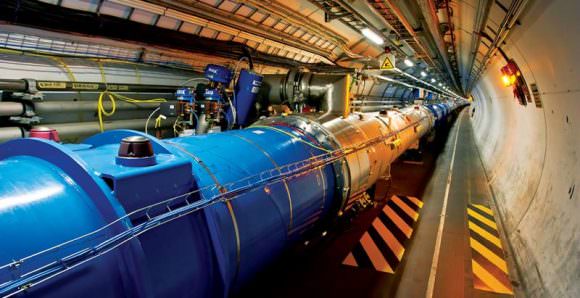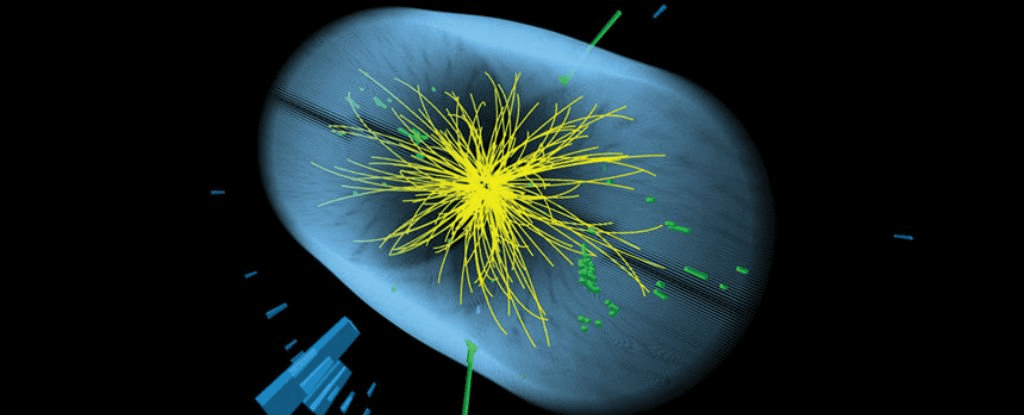Particle physicists are an inquisitive bunch. Their goal is a working, complete model of the particles and forces that make up the Universe, and they pursue that goal with a vigour matched by few other professions.
The Standard Model of Physics is the result of their efforts, and for 25 years or so, it has guided our thinking and understanding of particle physics. The best tool we have for studying physics further is the Large Hadron Collider (LHC), near Geneva, Switzerland. And some recent, intriguing results from the LHC points to the existence of a newly discovered particle.

The LHC has four separate detectors. Two of them are “general purpose” detectors, called ATLAS and CMS. Last year, separate experiments in both the ATLAS and CMS detectors produced what is best called a “bump” in their data. Initially, the two teams conducting the experiments were puzzled by the data. But when they compared them, they found that the bumps in their data were the same in both experiments, and they hinted at what could be a new type of particle, never before detected.
The two experiments involved smashing protons into each other at near-relativistic speeds. The collisions produced more high-energy photons than theory predicts. Not a lot more, but physics is a detailed endeavour, so even a slight increase in the amount of photons produced is a big deal. In physics, everything happens for a reason.
To be more specific, ATLAS and CMS recorded increased activity at an energy level around 750 giga electron-volts (GeV). What that means, for all you non-particle physicists, is that the new particle decays into two photons at the point of the proton-proton collision. If the new particle exists, that is.
A new particle would be a huge discovery. The Standard Model has describe all the particles present in nature pretty well. It even predicted the existence of one type of particle, the Higgs Boson, long before the LHC actually verified its existence. The discovery of a new type of particle would be very exciting news indeed, and could break the Standard Model.
Since this data from the experiments at the LHC was released last year, the physics world has been buzzing. Over 100 papers have been written to try to explain what the results might mean. But some caution is required.
The first thing scientists do when faced with results like this is to try to quantify the likelihood that it could be chance. If only one experiment had this bump in its data, then the likelihood that it was just a chance occurrence is pretty high. There are many reasons why an experiment can have a result like this, which is why repeatability is such a big deal in science. But when two independent, separate, experiments have the same result, people’s ears perk up.
A few months have passed since the experiments were run, and in that time, the experimenters have tried to determine exactly what the likelihood is of these result occurring by chance. After working with the data, a funny thing has happened. The significance of the extra photons detected by CMS has risen, while the significance of the extra photons detected by ATLAS has fallen. This has definitely left physicists scratching their heads.
Also in that time, about four main explanations for the experimental results have percolated to the surface. One states that the new particle, if it exists, is made up of smaller particles, similar to how a proton is made up of quarks. These smaller particles could be held together by an unknown force. Some theoretical physicists think this is the best fit with the data.
Another possibility is that the new particle is a heavier version of the Higgs Boson. About 12 times heavier. Or it could be that the Higgs Boson itself is made up of smaller particles, and that’s what the experiment detected.
![The Standard Model of Elementary Particles. Image: By MissMJ - Own work by uploader, PBS NOVA [1], Fermilab, Office of Science, United States Department of Energy, Particle Data Group, CC BY 3.0](https://www.universetoday.com/wp-content/uploads/2016/05/Standard_Model_of_Elementary_Particles.svg_-580x436.png)
Or, it could be the much-hypothesized graviton, the theoretical particle that carries the gravitational force. The four fundamental forces in the Universe are electromagnetism, the strong nuclear force, the weak nuclear force, and gravity. So far, we have discovered the particles that transmit all of those forces, except for gravity. If their was a new particle detected, and if it proved to be the graviton, that would be enormous, earth-shattering news. At least for those who are passionate about understanding nature.
That’s a lot of “ifs” though.
There are a lot of holes in our knowledge of the Universe, and physicists are eager to fill those gaps. The discovery of a new particle might very well answer some basic questions about dark matter, dark energy, or even gravity itself. But there’s a lot more experimentation to be done before the existence of a new particle can be announced.


I’m no expert, so I’d really value an expert opinion… it surprised me to hear about a graviton being a potential candidate at 750GeV because that’s a huge particle, and everything I’ve heard about gravitons is that they’re expected to be undetectably small, not extremely massive. How come a graviton is considered as a serious contender?
Gravity is supposed to have almost infinite range so the force carrier guage boson for it should be massless like the photon
Since we can feel gravity even in a deep cave means the graviton should be able to go through electrically charged protons/electrons in the thick cave walls , should it should have no charge.
This thing is 750 X 2 = 1500 Gev. so this might be something completely new.
All of this is pure speculation. Science used to be “do the work and when something was discovered announce it”. Now its all about the hype even if way too premature.
It’s the information age. What else can be said?
Science is sorry that it can’t provide you with instantaneous new knowledge. The scientific method is slow and methodical to verify facts and reduce mistakes. Hype is a product of journalists who create click bait.
A Draft paper describing an alternative to the Standard Model of particle physics has been written by Ken Rauen, AESOP’s Chief Technical Officer, (and the inventor of six of AESOP’s fuel-free engines). Titled: An Introduction to Temporal Wave Mechanics (TWM) it supplements Quantum Mechanics – copies are available upon request.
I’d read it. You got me at, “Temporal”! 😉
TWM predicted the new particle!
Now, instead of the well-publicized future discoveries of dark matter, supersymmetry, and all such other things we foisting some doubtfull 750 Gev hadrons.
They are not even able to find a link between the Higgs mechanism and 124.5 – 126 particle.
http://vixra.org/abs/1510.0105
Could this “unknown force” be a state of false vacuum?
Could this unknown force be a state of false vacuum?
Slight nitpick – I’m pretty sure the protons whizzing around the LHC (7 TeV, aren’t they?) are well past “near-relativistic”. 😆
One expects nothing less from the Large Hadron Collider! And yes.. it’s just a crying shame and too dang bad the USA did not build it’s Superconducting Super Collider (SSC). It would have had twenty times the collision energy and five times the energy of today’s LHC collisions. Oh well… it was rather traditional politics at work… not science.
The graviton will never be found…. because it doesn’t exist!
Don’t know where this crazies get their illusions that fail the present knowledge of the universe base on Higgs physics. Really, how smart to figure that Higgs particle has said to have failed the exploding Big Bang after the BOOM! Yet here we hear them talking as if the Standard Model is accurate supporting the whole course of the universe. Well sadly, Higgs boson along with its conjectures are pure myths meant only to fool the intelligent community. And Big Bang isn’t what we all thought it is, not with this Standard Model we use right now! Don’t even have to mention Dark Matter and its Dark energy. The only thing existing with this Physics scientists are the paying jobs they have for a good joke of tomorrow’s science.